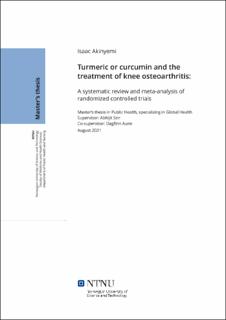| dc.description.abstract | Background: The prevalence of knee osteoarthritis (OA) is on the rise globally. This is partly due to the increase in proportion of people aged 60 years and older worldwide. Many of the current therapeutic options for the management of knee OA used in conventional medical practice have undesirable side effects which has led researchers to consider effective and safer alternatives. Curcumin, an herbal medicinal extract from the rhizome – turmeric has a favorable safety profile, and research evidence suggests that it is a viable option for the treatment of knee OA.
Objective: The objective of this systematic review and meta-analysis was to summarize and critically evaluate the published evidence from randomized controlled trials (RCTs) on the efficacy of curcumin in treating knee OA.
Methods: PubMed and Embase were searched for relevant RCTs published up until April 8, 2020. All RCTs that investigated the efficacy or effectiveness of curcumin in treating knee OA were included. Heterogeneity was assessed using I2 statistics, and the random effects models were selected to calculate weighted mean differences (WMD) and mean change differences (MCD) for the outcome measures – visual analog scale (VAS) and Western Ontario and McMaster Osteoarthritis Index (WOMAC) scores.
Results: Ten RCTs (n = 1272) were included in the meta-analysis. Curcumin significantly reduced pain (WMD for VAS (n = 3): -16.76 (-25.41, -8.11), I2 = 87.6%, Pheterogeneity = <0.001) and improved physical function (WMD for WOMAC physical function (n = 3): -8.63 (-10.17, -7.09), I2 = 0.0%, Pheterogeneity = 0.443) when compared with placebo. There was no difference in physical function (WMD for WOMAC physical function (n = 1): 0.15 (-0.30, 0.60), I2 = 0.0%, Pheterogeneity = .) when compared to ibuprofen or pain reduction (WMD for VAS (n=1): 0.00 (-0.24, 0.24), I2 = 0.0%, Pheterogeneity = .) when compared to diclofenac. Furthermore, sub-group analysis showed that difference in curcumin dosage (stronger association in doses >1000 mg/d) and type of control (RCTs with curcumin vs. active medication reported effect estimates closer to the null value) contributed significantly to the heterogeneity between the studies. Lastly, the incidence of adverse events was similar between curcumin and placebo but lower in the curcumin group when compared with active controls.
Conclusion: The findings from this review suggests that curcumin is a safe and effective option for treating the symptoms of knee OA. However, the number of RCTs included in the analysis along with their overall quality and the total sample size was not sufficient to draw firm conclusions. Further high quality RCTs with large sample sizes should be conducted in order to provide definitive evidence that allow the adoption of curcumin as a treatment for knee OA in clinical practice. | |
